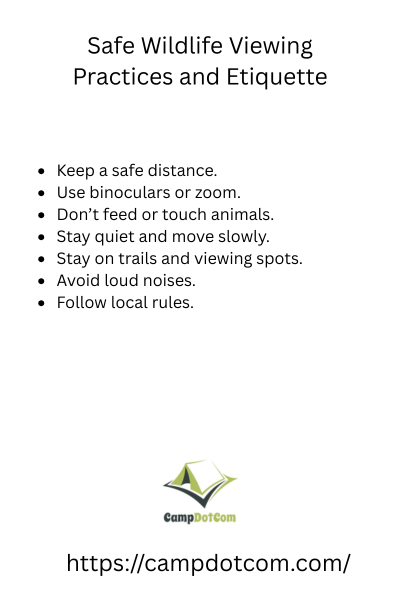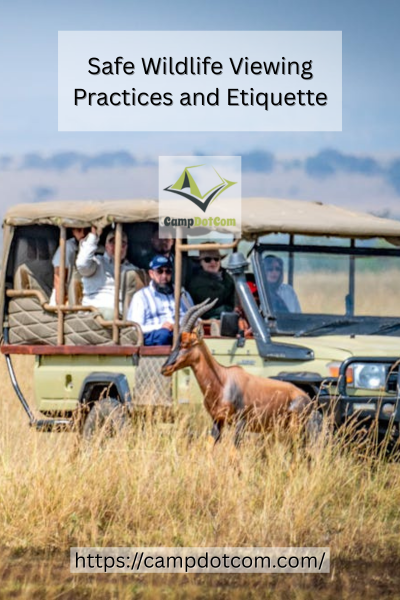Safe wildlife viewing practices and etiquette are things you don’t really think about until you’re that person in the park everyone’s side-eyeing for getting way too close to a wild animal. We’ve all seen it. Or maybe we were that person once. Guilty, right here. I’ll tell you about it in a sec.
The truth is, watching wildlife is one of the most awe-inspiring parts of being outdoors. But how we do it matters just as much as the experience itself. So let’s chat about how you can enjoy the moment and keep it safe for you, the animals, and everyone else out there.
Read More About Safe Wildlife Viewing Practices and Etiquette

That Time I Got Too Close…
Okay, here’s the story. A few years back, I was hiking in Montana when I saw a mama moose with her calf. My heart practically leapt out of my chest. I mean, they were right there! I slowly crept forward, camera in hand, trying to get a better angle. I thought I was being respectful with quiet steps and no sudden moves. But apparently, mama moose didn’t get the memo.
As an Amazon Associate, I earn from qualifying purchases. Some of the links in this article are affiliate links. This means that, at zero cost to you, I will earn an affiliate commission if you click through the link and finalize a purchase.
She turned and gave me that look. If you’ve ever seen a wild animal size you up, you know the one. That don’t test me stare. I froze and backed up. Lesson learned. That day, I realized safe wildlife viewing practices and etiquette aren’t just guidelines. They are lifesavers. And not just for you.
More Things to Know About Safe Wildlife Viewing Practices and Etiquette

Give Them Space (Like, More Than You Think)
One of the golden rules of safe wildlife viewing practices and etiquette is keeping your distance. If you are close enough to make an animal change its behavior like standing up, moving away, or giving you a hard stare, then you are too close.
And yes, that includes zooming in with your phone. We have all tried it. But digital zoom is no substitute for a real lens or even better, binoculars. Plus, do you really want your last selfie to be a bison charging at you?
Be Quiet, Stay Cool
Wild animals have sharp senses. Talking loudly, playing music too loud, or crashing through the underbrush does more than just ruin the peace it can really stress the animals. Try to blend in. Whisper if you need to talk. Walk like you are sneaking into a movie late. And definitely do not try to attract animals by calling out or using food. Trust me, they are not interested in your trail mix.
Know Before You Go
Different parks and wildlife areas have their own rules and it is up to you to know them. Some places require you to keep a safe distance from animals like bears or nesting birds. Others might close trails during breeding season. That is not just red tape it is all part of responsible travel and safe wildlife viewing practices and etiquette.
Before any trip, I always check the park’s website or stop by the visitor center. Rangers are a wealth of info, and they’ll usually share recent sightings or caution areas. Plus, they love when visitors actually care about doing things right.
Keep Pets on a Leash (Or Leave Them Home)
Look, I love dogs. But not all wild places are dog-friendly—and even the best-behaved pup can spook wildlife or leave behind scents that mess with animal routines. If pets are allowed, leashes are non-negotiable. If not, it’s a good excuse to treat them to a doggie daycare day.
Cameras Down, Eyes Up
We’re so busy trying to capture the perfect shot that we forget to actually watch. I’ve started putting my camera down for the first few minutes of any animal encounter. Just watching. Listening. Taking it all in. It’s more peaceful, more respectful, and honestly more memorable.
Plus, your presence affects animals. Standing still and quiet helps them relax and go about their business. You get a better show, and they stay safe. Win-win.
Trash Is Trouble
This one should go without saying but it still happens. Any trash like snack wrappers, water bottles, or fruit peels can harm wildlife. Animals might eat something they should not or start thinking humans are a source of food which never ends well. Always pack it in and pack it out.
Teach Others (Without Being That Guy)
If you see someone doing something risky or clueless, it’s okay to say something—but be kind. A simple, “Hey, just so you know, that animal might get spooked if we get too close,” goes a long way. People don’t usually mean harm; they just don’t know better. Sharing your knowledge helps keep everyone safer and reinforces good safe wildlife viewing practices and etiquette.
Connect with Nature by Watching Wildlife Safely
At the end of the day, safe wildlife viewing practices and etiquette are all about respect. Respect for the animals, the land, and the people who will come after you. Nature gives us an incredible chance to witness wild things in wild places, and it is up to us to protect that.
Next time you are out there, slow down. Watch from a distance. Breathe in the moment instead of pushing in for the perfect shot. You will feel more connected, and the wild animals will thank you, probably by pretending you are not even there. Which is exactly how it should be.
